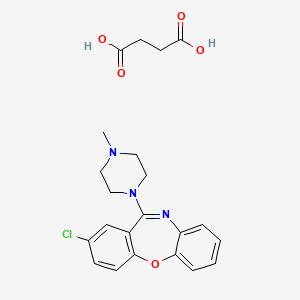



1. 2-chloro-11-(4-methyl-1-piperazinyl)-dibenz(b,f)(1,4)oxazepine
2. Cl 71,563
3. Cl-71,563
4. Cl71,563
5. Cloxazepine
6. Hydrochloride, Loxapine
7. Loxapine
8. Loxapine Hydrochloride
9. Loxapine Monohydrochloride
10. Loxapinsuccinate
11. Loxipine Maleate
12. Loxipine Succinate
13. Loxitane
14. Maleate, Loxipine
15. Oxilapine
16. Succinate, Loxapine
1. 27833-64-3
2. Loxapine Succinate Salt
3. Loxapac
4. Cloxazepin
5. Daxolin
6. Loxapine (succinate)
7. Loxapine, Succinate
8. Cl 71563
9. Loxapine,succinate
10. X59sg0mryu
11. Nsc-759578
12. Cl-71563
13. Cpd000058470
14. Mls000069383
15. Butanedioic Acid, Compd. With 2-chloro-11-(4-methyl-1-piperazinyl)dibenz[b,f][1,4]oxazepine (1:1)
16. Ncgc00016160-02
17. Lederle
18. Smr000058470
19. Cas-27833-64-3
20. Dsstox_cid_25227
21. Dsstox_rid_80764
22. Dsstox_gsid_45227
23. 2-chloro-11-(4-methyl-1-piperazinyl)dibenz(b,f)(1,4)oxazepine Succinate (1:1)
24. Chebi:6549
25. Loxapine Succinate [usan]
26. Butanedioic Acid;8-chloro-6-(4-methylpiperazin-1-yl)benzo[b][1,4]benzoxazepine
27. Butanedioic Acid, Compd. With 2-chloro-11-(4-methyl-1-piperazinyl)dibenz(b,f)(1,4)oxazepine (1:1)
28. Ccris 1917
29. Az-004
30. Sr-01000002971
31. Einecs 248-682-0
32. Unii-x59sg0mryu
33. Loxapine Succinate [usan:usp]
34. Staccato-loxapine
35. Loxitane (tn)
36. Prestwick_304
37. Mfcd00069298
38. Lopac-l-106
39. Opera_id_1518
40. Loxapine Succinate (usp)
41. 2-chloro-11-(4-methyl-1-piperazinyl)dibenzo[b,f][1,4]oxazepine Succinate
42. Schembl41643
43. Maprotilinehydrochloride
44. Mls000758291
45. Mls001146961
46. Mls001401432
47. Mls002222201
48. Spectrum2300242
49. Loxapine Succinate Salt, Solid
50. Regid_for_cid_71399
51. Loxapine Succinate [mi]
52. Chembl1201155
53. Dtxsid3045227
54. Hms1568k06
55. Hms1922l14
56. Hms2051e05
57. Hms2093n20
58. Hms2095k06
59. Hms2232n05
60. Hms3262o21
61. Hms3374f02
62. Hms3393e05
63. Hms3652o10
64. Hms3712k06
65. Hms3885h03
66. Loxapine Succinate [vandf]
67. Pharmakon1600-02300242
68. Loxapine Succinate [mart.]
69. Loxapine Succinate [usp-rs]
70. Loxapine Succinate [who-dd]
71. Tox21_110311
72. Tox21_500720
73. Az-104
74. Ccg-39497
75. Hy-17390a
76. Nsc759578
77. S4086
78. Akos015994711
79. Tox21_110311_1
80. Cs-4285
81. Ks-1083
82. Lp00720
83. Nc00011
84. Nsc 759578
85. Loxapine Succinate [orange Book]
86. Ncgc00016160-01
87. Ncgc00016160-03
88. Ncgc00016160-04
89. Ncgc00016160-05
90. Ncgc00021145-11
91. Ncgc00094068-01
92. Ncgc00094068-02
93. Ncgc00094068-03
94. Ncgc00261405-01
95. Loxapine Succinate [usp Monograph]
96. Succinic Acid, Compd. With 2-chloro-11-(4-methyl-1-piperazinyl)dibenz(b,f)(1,4)oxazepine (1:1)
97. Succinic Acid, Compound With 2-chloro-11-(4-methylpiperazin-1-yl)dibenz(b,f)(1,4)oxazepine (1:1)
98. Eu-0100720
99. Ft-0653022
100. Sw196603-4
101. Vu0239541-8
102. D00794
103. F14786
104. 833l643
105. Sr-01000002971-2
106. Sr-01000002971-6
107. Sr-01000002971-9
108. W-107092
109. Q27107236
110. 2-chloro-11-(4-methylpiperazin-1-yl)dibenzo[b,f][1,4]oxazepine Succinate
111. 2-chloro-11-(4-methylpiperazin-1-yl)dibenzo[b,f][1,4]oxazepinesuccinate
112. Loxapine Succinate, United States Pharmacopeia (usp) Reference Standard
113. (e)-2-chloro-11-(4-methylpiperazin-1-yl)dibenzo[b,f][1,4]oxazepine Succinate
| Molecular Weight | 445.9 g/mol |
|---|---|
| Molecular Formula | C22H24ClN3O5 |
| Hydrogen Bond Donor Count | 2 |
| Hydrogen Bond Acceptor Count | 7 |
| Rotatable Bond Count | 4 |
| Exact Mass | 445.1404486 g/mol |
| Monoisotopic Mass | 445.1404486 g/mol |
| Topological Polar Surface Area | 103 Ų |
| Heavy Atom Count | 31 |
| Formal Charge | 0 |
| Complexity | 542 |
| Isotope Atom Count | 0 |
| Defined Atom Stereocenter Count | 0 |
| Undefined Atom Stereocenter Count | 0 |
| Defined Bond Stereocenter Count | 0 |
| Undefined Bond Stereocenter Count | 0 |
| Covalently Bonded Unit Count | 2 |
| 1 of 2 | |
|---|---|
| Drug Name | Loxapine succinate |
| Drug Label | Loxapine, a dibenzoxazepine compound, represents a subclass of tricyclic antipsychotic agents, chemically distinct from the thioxanthenes, butyrophenones, and phenothiazines. Chemically, it is 2-Chloro-11-(4-methyl-1-piperazinyl)dibenz[b,f][1,4]oxaze... |
| Active Ingredient | Loxapine succinate |
| Dosage Form | Capsule |
| Route | Oral |
| Strength | eq 5mg base; eq 50mg base; eq 10mg base; eq 25mg base |
| Market Status | Prescription |
| Company | Lannett Holdings; Watson Labs; Mikah Pharma; Mylan |
| 2 of 2 | |
|---|---|
| Drug Name | Loxapine succinate |
| Drug Label | Loxapine, a dibenzoxazepine compound, represents a subclass of tricyclic antipsychotic agents, chemically distinct from the thioxanthenes, butyrophenones, and phenothiazines. Chemically, it is 2-Chloro-11-(4-methyl-1-piperazinyl)dibenz[b,f][1,4]oxaze... |
| Active Ingredient | Loxapine succinate |
| Dosage Form | Capsule |
| Route | Oral |
| Strength | eq 5mg base; eq 50mg base; eq 10mg base; eq 25mg base |
| Market Status | Prescription |
| Company | Lannett Holdings; Watson Labs; Mikah Pharma; Mylan |
Antipsychotic Agents
Agents that control agitated psychotic behavior, alleviate acute psychotic states, reduce psychotic symptoms, and exert a quieting effect. They are used in SCHIZOPHRENIA; senile dementia; transient psychosis following surgery; or MYOCARDIAL INFARCTION; etc. These drugs are often referred to as neuroleptics alluding to the tendency to produce neurological side effects, but not all antipsychotics are likely to produce such effects. Many of these drugs may also be effective against nausea, emesis, and pruritus. (See all compounds classified as Antipsychotic Agents.)
Dopamine Antagonists
Drugs that bind to but do not activate DOPAMINE RECEPTORS, thereby blocking the actions of dopamine or exogenous agonists. Many drugs used in the treatment of psychotic disorders (ANTIPSYCHOTIC AGENTS) are dopamine antagonists, although their therapeutic effects may be due to long-term adjustments of the brain rather than to the acute effects of blocking dopamine receptors. Dopamine antagonists have been used for several other clinical purposes including as ANTIEMETICS, in the treatment of Tourette syndrome, and for hiccup. Dopamine receptor blockade is associated with NEUROLEPTIC MALIGNANT SYNDROME. (See all compounds classified as Dopamine Antagonists.)